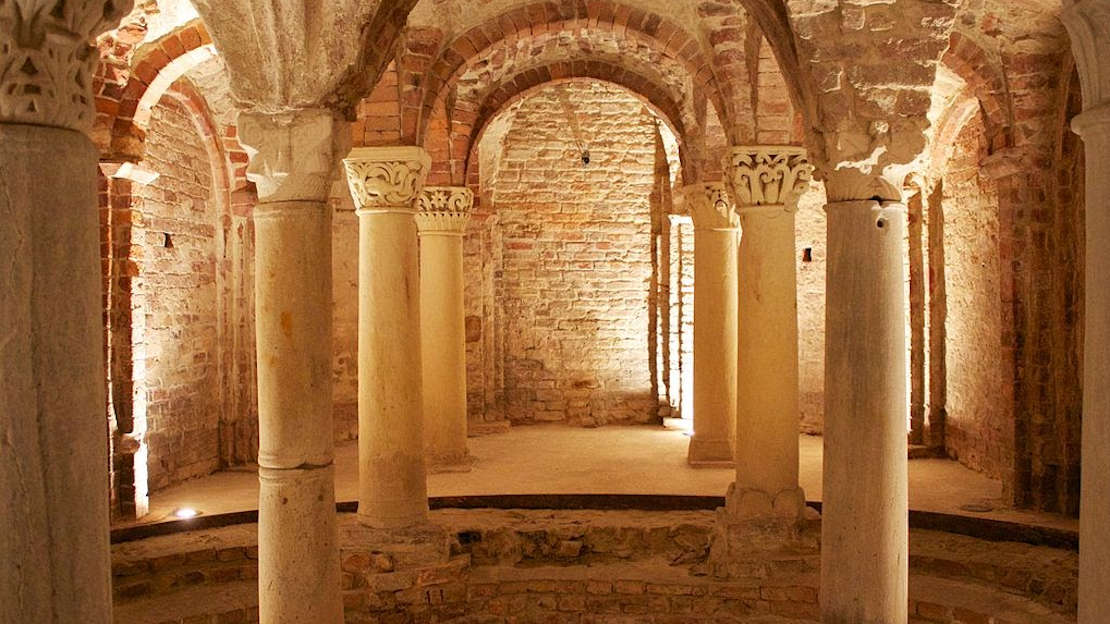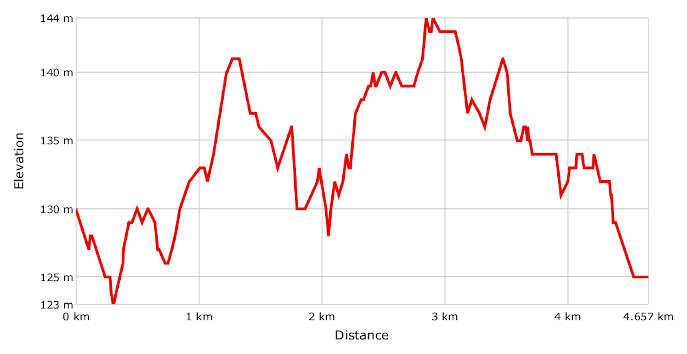
- Bike: strada/trekking
- Difficulty: *
- Distance: 5 km
- Altitude difference: 21 m
- Total ascent: 35 m
- Total descent: 40 m

This is a very short route, a tour of the main landmarks bearing witness to the town of Asti's medieval past.
Asti was originally a Ligurian settlement and became a Roman town by the name of Hasta Pompeia in 89 BC. The Torre Rossa remains from the latter period. After a spell as a Lombard duchy, it was a thriving free town from the 11th century. Up until the 13th century, Asti was one of Northern Italy’s richest places and a strategic centre for commerce and banking. The Savoyards were to arrive in the 16th century. After the disorder of the French Revolution, Asti revolted in 1797 against the Savoyard government, leading to the proclamation of the Republic of Asti. This was to last only three days however, ending with the rebels being shot. Most of the town’s medieval walls were demolished in the 19th century, as part of an urban modernisation and building project.
The town features much architectural evidence of the medieval period, certainly enough to justify a tour by bike, which lets you travel quickly between the various historic landmarks and buildings. The short itinerary has 18 stops of historical interest on the route described below. The only accessory recommended for tourists on bikes is a lock for securing it at the various stops, in addition to a camera of course.
Start from Piazza Vittorio Alfieri, near Piazza del Palio, where there is a large car park. Take Via G. Garibaldi up to Piazza San Secondo, the location of the first stop, the collegiate church of San Secondo. Tradition has it that the church was built on the spot where its saint was martyred. It is known as a collegiata since it was home to a college of canons. In the first chapel on the right is the banner for the Palio di Asti, run in honour of the patron saint. Also in Piazza San Secondo is the second stop, Palazzo di Città, a baroque building which is the work of Benedetto Alfieri. Continue for a few metres on Via Camillo Benso di Cavour, where the third stop allows you to admire the Palazzo degli Antichi Tribunali, which houses the local courts and council offices. Opposite the third stop is Piazza Statuto, or Piazza delle Erbe, which was a major commercial centre from as far back as the medieval period. It was once the location of one of the town’s most important markets, and contains the fourth stop, the Torre dei Guttuari, dating to the initial period of tower building in Asti in the 7th and 8th centuries.
Continue the tour, following the GPX track and observing the directions of traffic in the town, on Via Quintino Sella up to the Via San Martino crossroads. This is the fifth stop, where you can admire the Torre di Lombriasco, an imposing medieval tower, cut off with an inclined plane, situated in a picturesque baroque building. It is what remains of the Ponte family’s aristocratic residence. This noble Guelph family can be traced to the end of the 13th century. Opposite this is the Casa dei Roero di Cortanze. This building was home to the Roero family in the Middle Ages but was modernised extensively in the 18th century.
Keep following the track for Via San Martino then turn left on Corso Vittorio Alfieri to reach the sixth stop, the crypt and museum of Sant’Anastasio. This is to be found beneath the early medieval religious complex of Sant’Anastasio, demolished in 1907. The crypt is annexed to the museum of the same name, with extensive remains from the church of Sant’Anastasio. Keep straight on for some metres to the seventh stop, on the left. The handsome 13th-century Torre De Regibus, at the junction of Via Roero and Corso Alfieri. This is the only surviving example of an octagonal tower in Asti and was part of a complex of buildings belonging to the De Regibus family. The tour continues to the eighth stop, turning left on Via G. Mazzini to Palazzo Malabaila, built in 1494. Set off again on Via Malabaila to Piazza San Martino, pushing your bike by hand against traffic for a few metres. There are two stops here. First is the ninth, Torre dei Monteu, alongside one of the palazzi belonging to the Roero family – the Monteu side to be exact – which owned many buildings in the area around the street named after them. The church of San Martino, the 10th stop, is a striking sight for visitors in Piazza San Martino. The 14th-century structure was demolished between 1695 and 1696 and seems to have been rebuilt according to a design by the Barnabite Giovanni Ambrogio Mazenta. The route continues along the one-way Via Roero, turning right on Via Quintino Sella and then right again, after Piazzetta Montafia, on Via Don Urbano Isnardi until you reach the 11th stop, the splendid Torre Rossa. One of the ancient Roman gates to the town was once in the area occupied by the church of Santa Caterina today. It received travellers arriving from the road to Turin and featured a structure which must have recalled the better-known Palatine gate in that city, with its two towers flanking an arched entrance. Only one of the two towers remains today in Asti, on the south side of Corso Alfieri, going by the name of Torre Rossa ('red tower'). The route continues on Via del Varrone to Palazzo Mazzola for the 12th stop. Palazzo Mazzola was built on a medieval structure and now houses the Municipal Historical Archive. Set off again for the 13th stop, at the nearby cathedral of Santa Maria Assunta, built between 1295 and 1350. The cathedral of the Assunta in Asti is one of the most beautiful examples of Gothic religious architecture in Piedmont, admirably bearing witness to the artistic taste that distinguished this area. Follow the GPX track to the 14th stop and visit the Torre Natta and Palazzo Natta. At the junction of Via Natta and Via Milliavacca is a tower which together with the nearby palazzo formed a solid and very heavily fortified house. The tower was probably built in the 12th century. Continue on Via Milliavacca and turn left on Via G. Carducci to reach the 15th stop, the Torre Solaro. This structure dates to the latter half of the 13th century and is Gothic in style. The sides are 8.1 m at the base and the tower belongs to the 'giant' group of the second period. Further on, in Piazza del Seminario, is the 16th stop, Palazzo Bunej, the bishop’s palace since the 15th century. Palazzo Bunej is an imposing 13th-century complex which is heavily fortified with defences. The tour continues with nearby Piazza Roma, with its monument to Italian unification at the centre. This is the location of the 17th stop, where you can admire the 13th-century Torre Comentina, which is now incorporated in the 20th-century castle overlooking the square. This is the town’s second tallest civil tower at 38.55 m.
After this stop comes the last visit. Set off and follow Corso Vittorio Alfieri, in the opposite direction to the tower, until the left turn on Via F. Della Valle that leads to Piazza Medici. The fountain of the aqueduct of Cantarana is to be found at its centre. This is the 18th and final stop, the Torre Troiana or Torre dell’Orologio, which stands out from the vantage point of the square and is one of Asti’s architectural symbols. The noble Troja family’s palazzo and tower complex must historically have been one of the most prestigious in the town. The tower has now been restored to its historic splendour. It is possible to visit it and take in a beautiful 360° view of the town from the top. It’s a short return stretch after the visit to the tower – a matter of metres from Via Cesare Battisti to the starting point in Piazza Vittorio Alfieri. Here you can admire a monument to one of the most celebrated figures from Asti, count Vittorio Amedeo Alfieri (Asti, 16 January 1749 – Florence, 8 October 1803), a great Italian playwright, poet and writer.
